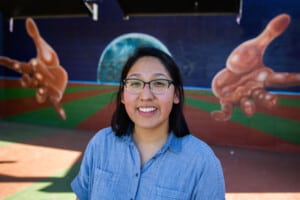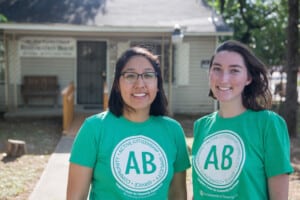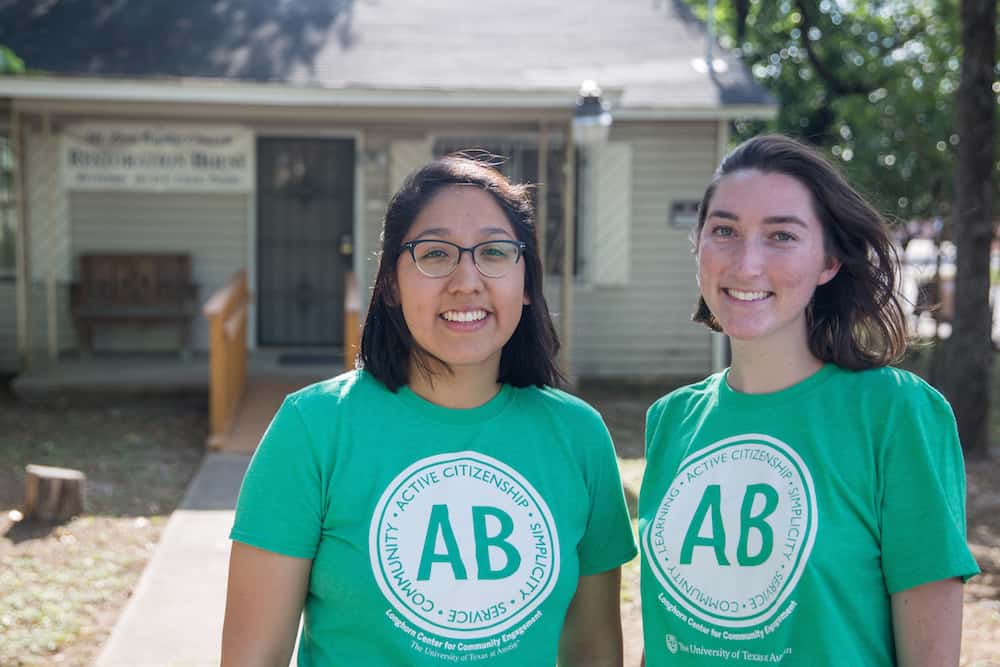An alternative Spring Break to record East Austin residents’ views on gentrification
Spending a week crammed in a small house in East Austin with eight other people may not be an ideal Spring Break for most UT students. And yet, this was the choice of social work undergraduates Cassandara Najera, Renee Palma, and Sarah Hudson. This spring, the three of them signed up for Alternative Breaks, a program with the Longhorn Center for Community Engagement that sends UT students to communities around the United States to learn about social justice through an immersive service experience.

“The overall goal of Alternative Breaks is to give students the opportunity to see stories and experiences that are outside the university and that they might not be aware of,” explains Najera, an articulate social work senior who has gone on Alternative Breaks since 2014 and was one of the Austin trip leaders. “For the East Austin trip we just did, we wanted to use digital storytelling to highlight the narratives of long-time residents who are experiencing gentrification.”
Najera and another trip leader were responsible for a group of eight students – Palma and Hudson among them. Starting in January, Najera co-led pre-trip meetings on Sundays, when the group learned about the history of East Austin as well as how to use a video-camera. Najera also helped identify East Austin community members and organizations that students could reach out to for interviews.
“During the pre-trip meetings we discussed issues like the 1928 Koch and Fowler city plan, which created a ‘Negro District’ and pushed people of color east of Interstate 35. We also talked about how these same people are now being pushed out of that area as gentrification brings higher property taxes. And then the goal for students was to understand how all these larger processes relate to a person’s story, and create videos that highlight those personal narratives,” Najera explains.
Palma, a first-year student from San Antonio who recently changed her major from psychology to social work, says she didn’t know much about East Austin before the trip.

“I actually had heard bad things about it on campus, like it was unsafe or dangerous, although I never really understood that because it felt like home to me when I went there,” she elaborates. “With Alternative Breaks, I loved the idea that instead of learning about gentrification in the classroom, I was going to be in East Austin, experiencing it and learning about it from the people who have been there for generations in some cases.”
When Spring Break came, the group moved to a house owned by the Mount Zion Baptist Church.
“Even though we didn’t leave Austin, people felt they were somewhere else,” Najera says. “We had mats to sleep on the floors, kind of like camping. There was no TV and people could use cell phones for designated amounts of time only. The idea was to create a community and immerse students in what they were learning, so it’s not a trip where they are volunteering and posting pictures on social media, and that’s it.”
In addition to giving students time to interview East Austin residents and produce the final videos, the trip included visits to organizations such as the George Washington Carver Museum and Cultural Center; Six Square, a nonprofit dedicated to celebrate the African American heritage of Central East Austin and preserving cultural assets; and Casa Marianella, an emergency homeless shelter that serves recently arrived immigrants and asylum seekers. Students also volunteered with the Inside Books Project, an organization that sends free books and educational materials to incarcerated individuals in Texas.
“I felt like I was able to build relationships with parts of the Austin community that tend to be overlooked,” Hudson reflects. “It was eye-opening to see how different living in East Austin is from living on campus, even though both places are just a few miles apart. I’m so glad I was exposed to the vibrant history and culture of the area.”
Hudson and a partner interviewed Susana Almanza, a community activist and founder of the nonprofit Poder, which focuses on environmental and social justice issues in East Austin.
“Speaking with and hearing from individuals whose lives and families have been negatively affected by gentrification made me realize that there’s this whole other side to the common, positive narrative of East Austin growing and becoming trendy. I hope to keep working to change apathetic attitudes around gentrification. As university students, it’s so easy to live in a bubble and not really engage with the surrounding communities,” Hudson says.
Palma and her partner interviewed Lori Renteria, who helped develop the Tejano Walking Trail, a 4.9 mile route that features 22 historical and cultural landmarks in the East Cesar Chavez and Holly neighborhoods.
“We wanted to learn about her life and experience,” Palma says. “We interviewed her for two hours, and she had so many good stories that it was hard to shave everything down to three minutes! We showed a longer first draft to the group, and decided to go with the story that popped up the most for everyone, which was about her work with youth gang members. It was a very collaborative process.”
Both Palma and Hudson hope to keep engaged with East Austin, and to bring what they learned during the break back to campus. For now, Palma shares, Alternative Breaks definitely changed her perception of Austin:
“When I came to Austin, I really didn’t like it. As students, all we see is the area around campus. But if we are able to branch out, and make more of a connection with other parts of the city, it completely changes your experience. Being in East Austin for that week made me discover the city in new ways and love it!”
By Andrea Campetella. Posted May 5, 2017.


